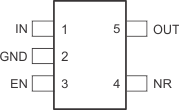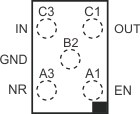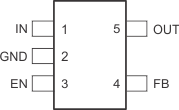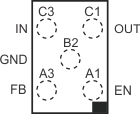SBVS056L January 2005 – February 2022 TPS799
PRODUCTION DATA
- 1 Features
- 2 Applications
- 3 Description
- 4 Revision History
- 5 Pin Configuration and Functions
- 6 Specifications
- 7 Detailed Description
- 8 Application and Implementation
- 9 Power Supply Recommendations
- 10Layout
- 11Device and Documentation Support
- 12Mechanical, Packaging, and Orderable Information
Package Options
Mechanical Data (Package|Pins)
Thermal pad, mechanical data (Package|Pins)
- DRV|6
Orderable Information
5 Pin Configuration and Functions
 Figure 5-1 DDC Package (Fixed),5-Pin SOT-23-THIN(Top View)
Figure 5-1 DDC Package (Fixed),5-Pin SOT-23-THIN(Top View) Figure 5-3 YZU Package (Fixed),5-Pin DSBGA(Top View)
Figure 5-3 YZU Package (Fixed),5-Pin DSBGA(Top View) Figure 5-5 DRV Package (Fixed),6-Pin WSON With Exposed Thermal Pad(Top View)
Figure 5-5 DRV Package (Fixed),6-Pin WSON With Exposed Thermal Pad(Top View) Figure 5-2 DDC Package (Adjustable),5-Pin SOT-23-THIN(Top View)
Figure 5-2 DDC Package (Adjustable),5-Pin SOT-23-THIN(Top View) Figure 5-4 YZU Package (Adjustable),5-Pin DSBGA
(Top View)
Figure 5-4 YZU Package (Adjustable),5-Pin DSBGA
(Top View) Figure 5-6 DRV Package (Adjustable),6-Pin WSON With Exposed Thermal Pad
(Top View)
Figure 5-6 DRV Package (Adjustable),6-Pin WSON With Exposed Thermal Pad
(Top View)Table 5-1 Pin Functions
| PIN | I/O | DESCRIPTION | |||
|---|---|---|---|---|---|
| NAME | DDC | YZU | DRV | ||
| IN | 1 | C3 | 6 | I | Input supply. |
| GND | 2 | B2 | 3, Pad | — | Ground. The pad must be tied to GND. |
| EN | 3 | A1 | 4 | I | Driving this pin high turns on the regulator. Driving this pin low puts the regulator into shutdown mode. EN can be connected to IN if not used. |
| NR | 4 | A3 | 2 | — | Fixed voltage versions only. Noise reduction; connecting this pin to an external capacitor bypasses noise generated by the internal band gap. This capacitor allows output noise to be reduced to very low levels. |
| FB | 4 | A3 | 2 | I | Adjustable voltage version only. Feedback; this pin is the input to the control loop error amplifier, and sets the output voltage of the device. |
| OUT | 5 | C1 | 1 | O | Output of the regulator. To assure stability, a small ceramic capacitor (total typical capacitance ≥ 2 μF) is required from this pin to ground. |
| N/C | — | — | 5 | — | Not internally connected. This pin must either be left open, or tied to GND. |